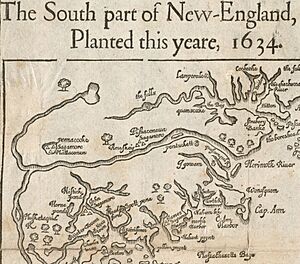Pawtucket tribe facts for kids
| Total population | |
|---|---|
| extinct as a tribe | |
| Regions with significant populations | |
| northeastern Massachusetts, southern New Hampshire |
|
| Languages | |
| possibly Algonquian language | |
| Religion | |
| Indigenous religion | |
| Related ethnic groups | |
| Naumkeag people, Pennacook |
The Pawtucket tribe was a group of Native American people. They lived in what is now northeastern Massachusetts and southeastern New Hampshire. They spoke a language from the Eastern Algonquian family.
We know about the Pawtucket tribe mostly from their interactions with early English colonists in the 1600s. Sometimes, old documents call them by different names. These names include Pawtucket, Naumkeag, Wamesit, or Mystic Indians. They might also be called by the name of their leader, known as a sachem or sagamore.
Contents
Where the Pawtucket Lived
The Pawtucket people lived in the Merrimack Valley. This area is in northeastern Massachusetts and southeastern New Hampshire today. Their homes were near the Pawtucket Falls. This is close to the city of Lowell, Massachusetts now.
The Pawtucket Tribe's Story
Early Leaders and Challenges
When Europeans first arrived, Nanepashemet was a main leader, called a sachem. He controlled a large area of land. This land stretched from the Charles River north to the Piscataqua River. It also went west to the Concord River.
In 1617, Nanepashemet was killed in a fight. This happened near what is now Medford, Massachusetts. He was fighting against the Tarrantines, who were likely Miꞌkmaq people. His burial place was later found by Edward Winslow.
After Nanepashemet died, his wife became the leader. She is known as the Squaw Sachem of Mystic. She ruled the area with her three sons. Their names were Wonohaquaham (also called "Sagamore John"), Montowampate (also called "Sagamore James"), and Wenepoykin (also called "Sagamore George").
Another important Pawtucket chief was Passaconaway. He was also a main sachem. He led the Wamesit, Pascataqua, and Pennacook peoples too.
Facing New Diseases
In December 1633, a terrible sickness spread. It was a smallpox epidemic. This disease killed many people, including Wonohaquaham and Montowampate. A large part of the Pawtucket tribe also died.
This left Wenepoykin and the Squaw Sachem as leaders. They now led a much smaller group of people. When the Squaw Sachem died around 1650, Wenepoykin became the only sachem. His territory reached from present-day Winthrop to Malden, North Reading, Lynn, and even Salem.
Wenepoykin tried to keep his land using the settlers' laws. But his efforts did not work very well. Over the next 20 years, the tribe's size kept shrinking. The British government and the Massachusetts court moved Native Americans into special villages. These were called praying towns. Some people from Wenepoykin's family joined these towns.
King Philip's War and Its Impact
In 1675, Wenepoykin and some Pawtucket people joined Metacomet. Metacomet was also known as King Philip. They fought in a big conflict called King Philip's War. This war changed everything for Native Americans in New England. It was especially hard for the Pawtucket and Naumkeag people.
Wenepoykin was captured in 1676. He was then sold into slavery in Barbados. At the same time, over 1,000 Native Americans who were not fighting were sent away. Some of them were originally Pawtucket. They were held on Deer Island. Only 167 of them survived and returned to the praying towns.
After eight years, Wenepoykin came back to Massachusetts. A missionary named John Eliot helped him return. Wenepoykin joined some of his family in Natick. But he died later that same year. He left his lands to a relative named Quonopohit. Quonopohit was also known as James Rumney Marsh. By this time, most of the Pawtucket's traditional land was taken by English settlers.
Quonopohit and other relatives tried to get payment for the Pawtucket lands. These lands were in what is now northeastern Massachusetts. They worked on this in the 1670s and 1680s.
After this, the Pawtucket's story mixes with other Native American groups. These groups joined together in the remaining praying towns. These towns included Wamesit and Natick. Some Pawtucket people may have also gone north. They might have joined the Wabanaki Confederacy. This group had more success in fighting back European settlers. This happened along the coast of Maine during King Philip's War, also called the First Abenaki War.


